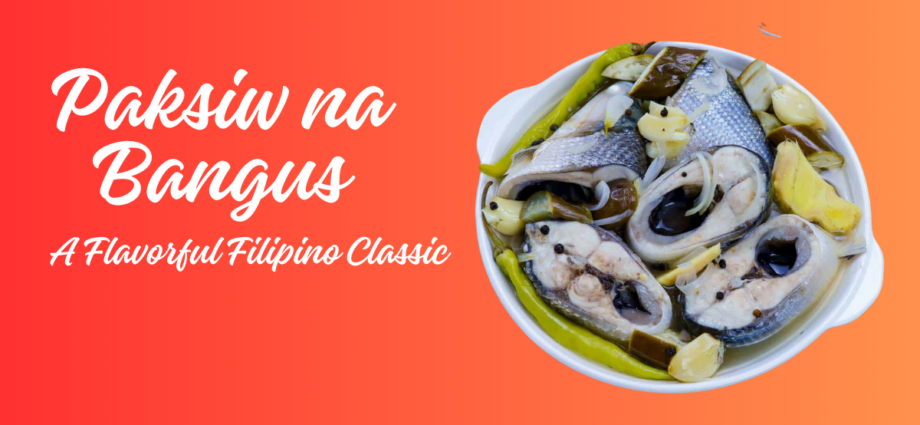Paksiw na Bangus is a classic Filipino dish that beautifully balances the flavors of sourness and savory richness. Derived from the cooking technique called “paksiw”, which refers to simmering meat or fish in vinegar, this dish has long been a staple in Filipino households due to its simplicity, preservative qualities, and delicious flavor. The star of the dish is bangus or milkfish, the national fish of the Philippines, which is beloved for its rich taste and tender flesh.
Geographic Origins and Cultural Significance
The origin of paksiw can be traced back to the Philippines’ coastal regions, where fresh fish is abundant, and vinegar is commonly used as a preservative to extend the shelf life of seafood. Vinegar-based dishes have been a practical solution for Filipino families to preserve food in a tropical climate. Pangasinan, one of the provinces known for its bangus farms, holds a special place in this dish’s history, and to this day, paksiw na bangus remains one of the most popular ways to prepare this fish. The abundance of coconuts and vinegar in Filipino cuisine also reinforces paksiw as an essential method for cooking and preserving various dishes.
Paksiw has become a cultural symbol of home-cooked meals across the Philippines. As one of the many forms of lutong bahay (home-cooked food), paksiw na bangus brings families together around the dining table. It is commonly eaten during lunch or dinner, paired with hot steamed rice to balance the dish’s tangy and savory flavors. The use of vinegar in paksiw not only adds flavor but also functions as a natural preservative, making it a practical choice for busy households.
You Might Also Be Interested: Exploring the Flavorful Chicken Adobo: A Filipino Classic
Flavor Profile
The flavor of paksiw na bangus is unmistakably tangy, with vinegar serving as the primary flavor base. As the vinegar reduces during cooking, it mellows out, leaving behind a pleasantly sharp but well-rounded sourness. This is complemented by the savoriness of garlic, onions, and optional shrimp paste (bagoong) or soy sauce. Chili peppers are often added for a mild to moderate heat, depending on the region and personal preference. The inclusion of ampalaya (bitter melon) or eggplant introduces an earthy bitterness or subtle sweetness, which adds complexity to the dish.
The beauty of paksiw na bangus lies in its minimal ingredients but bold flavors. Each bite is an explosion of tangy, savory, and sometimes spicy notes, with the vinegar and garlic cutting through the richness of the milkfish.

Classic Paksiw na Bangus Recipe
For those looking to bring a taste of Filipino cuisine into their kitchen, paksiw na bangus is a fantastic starting point. This recipe is easy to prepare and offers authentic Filipino flavors.
Ingredients:
- 1 medium-sized bangus (milkfish), cleaned and cut into steaks
- 1/2 cup vinegar (preferably cane vinegar)
- 1/4 cup water
- 1 medium onion, sliced
- 5 cloves garlic, crushed
- 1 thumb-sized piece of ginger, sliced thinly
- 1-2 green chili peppers (optional, for heat)
- 1/2 tsp peppercorns
- 1-2 tbsp soy sauce or bagoong (shrimp paste)
- Salt and pepper to taste
- Optional: 1 small ampalaya (bitter melon) or eggplant, sliced
Instructions:
- Prepare the Fish: Clean the bangus thoroughly and slice it into steaks. Set aside.
- Layer the Ingredients: In a wide skillet or pot, arrange the bangus steaks along with the garlic, ginger, onions, and peppercorns. If using ampalaya or eggplant, place them on top of the fish.
- Add Liquids: Pour in the vinegar and water over the fish and vegetables. Drizzle soy sauce or shrimp paste for added umami. Season with salt and pepper to taste.
- Simmer Gently: Bring the mixture to a simmer over medium heat, without stirring to avoid breaking the fish. Let the fish cook for about 10-15 minutes until the vinegar reduces, and the fish becomes tender. Add the chili peppers for heat if desired.
- Finish: Once the fish is fully cooked and the sauce has reduced, remove from heat. Taste the sauce and adjust seasoning as needed.
- Serve: Serve hot with steamed rice. For added flavor, drizzle with more vinegar or soy sauce.
You Can Also Check: Pancit Canton: A Journey Through Filipino Culinary Heritage
Variations of Paksiw na Bangus
Paksiw na Bangus can be adjusted to suit individual preferences or local ingredients. Some variations include:
- Paksiw na Bangus sa Gata: In some regions, particularly in Bicol, coconut milk is added at the end of the cooking process to give the dish a creamy texture, balancing the acidity of the vinegar.
- With Eggplant or Bitter Melon: Adding vegetables like eggplant or ampalaya introduces a different texture and taste, creating a more well-rounded dish. Bitter melon adds a sharp contrast to the sourness of the vinegar, while eggplant adds a hint of sweetness.
- Regional Twists: Some provinces substitute bangus with other types of fish like tilapia or galunggong (mackerel scad), while maintaining the same paksiw base.
Cooking Tips
- Use cane vinegar for an authentic Filipino flavor. Other vinegars like apple cider vinegar can be used, but they may alter the dish’s traditional taste.
- Do not stir while simmering: Stirring too early can cause the fish to break apart. Let it simmer undisturbed until fully cooked.
- If using ampalaya (bitter melon), soak the sliced pieces in salted water for a few minutes before cooking to reduce bitterness.
Conclusion
Paksiw na Bangus is a testament to the simplicity and ingenuity of Filipino cuisine, where a few essential ingredients come together to create a dish that is flavorful, comforting, and rich in history.
Its roots in the coastal and agricultural regions of the Philippines remind us of the importance of sustainable cooking and the use of local ingredients.
Whether enjoyed as a family meal or at a gathering, paksiw na bangus continues to hold a special place in the hearts—and kitchens—of Filipinos everywhere. It’s a dish that speaks to the essence of home, with its bold and tangy flavors offering an authentic taste of the Philippines.
You Might Also Like:
Nasi Goreng with Egg: Unraveling the Indonesian Culinary Gem
The Journey of Pad Thai: From Streets of Thailand to Your Plate
Savory Delight: Journey into Filipino Cuisine with Balbacua
Exploring the Flavorful Chicken Adobo: A Filipino Classic
Crispy Fried Chicken Delight: A Filipino Favorite
Exploring the Savory Delight of Bulalo: Origin, Flavor, and Recipe
- Top Digital Nomad Cities in Latin America (2026 Edition) - 15 December 2025
- Top Digital Nomad Cities in Europe (2026 Edition) - 14 December 2025
- Top Digital Nomad Cities in Asia (2026 Edition) - 14 December 2025











